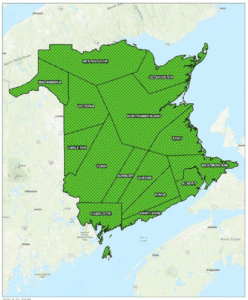Invasive plant’s sap harmful to humans, animals
A phototoxic invasive plant species imported from Europe and Asia is causing problems for District of Carleton North residents.
According to the Canadian Invasive Species Centre, Wild Parsnip, whose root is edible, is an invasive species that spreads rapidly and “outcompete[s] native plants, reducing biodiversity and the quality of agricultural forage crops such as hay, oats, and alfalfa.
” It can also affect crop pollination as honeybees do not visit the plant, and it’s known to “disrupt pollinator-friendly plants such as goldenrod.” The rapid spread has farmers concerned.
Anna Belliveau, CEO of the Agricultural Alliance, told the River Valley Sun that they have formed a working group that includes representatives from the Department of Transportation and Infrastructure (DTI) and a weed specialist from the Department of Agriculture. The group’s mission is to find out how widespread the issue is so that the DTI can increase its 2025 budget to combat the spread of the plant by “mowing affected areas before [the plants] goes to seed and gets into the fields.”
However, the danger of the plant’s spread extends beyond its effect on crops. As a phototoxic species, the plant’s sap is harmful. When skin comes into contact with the sap (brushing up against the plant), it can cause a severe, painful, burning and blistering rash. If any of the sap gets in your eyes, it can cause temporary or even permanent blindness.
As for the plant’s effects on animals, a technician with Woodstock Veterinary Clinic told the River Valley Sun that while an animal’s fur often protects it from skin reactions, the sap is toxic when ingested when the animals clean themselves, eat the plant directly, or consume water surrounding the plant.
According to information distributed by Service Ontario, if large livestock ingests the plant, it can cause fertility and weight issues. For smaller animals such as cats and dogs, the effects of ingestion can be even more extreme and, according to the ASPCA, include symptoms such as “diarrhea, seizures, tremors, bloat, respiratory depression, and death.”
Carleton North council members raised concerns about the plant’s threat at the municipality’s July 23 meeting.
Deputy Mayor Karen Hargrove noted that the plant is growing alongside roads throughout the county and is no longer just an “agricultural concern.”
Councillor Angel Connors pointed out that a large patch of dangerous weed is growing behind the Northern Carleton Recreational Centre by the ball field, posing a risk to children.
Councillor Scott Oakes expressed his concern that if left unchecked, it will “get to the point that you can’t walk down to the brook to fish or go for a walk in the woods without risk of coming into contact with it.”
Unfortunately, there are no quick fixes, and eradication efforts will take years. For now, the Nature Conservancy of Canada has some recommended measures that property owners can take.
For small patches, they suggest digging up the plants (including the roots) “when they are still small in the spring. Plant material should be left to dry and then left in black garbage bags in the sun for a week or more prior to disposal in a landfill.”
For larger areas, they recommend mowing and covering with tarps to prevent regrowth or the use of herbicides in the spring or fall. They warn that people should use “extreme caution to avoid skin contact with the plant,” including wearing protective equipment such as gloves, coveralls, and goggles” when removing the plant.
District of Carleton North Mayor Andrew Harvey encourages residents to report any patches of the plant they find to the district office so it can be handled accordingly and so they can relay the information to DTI.














